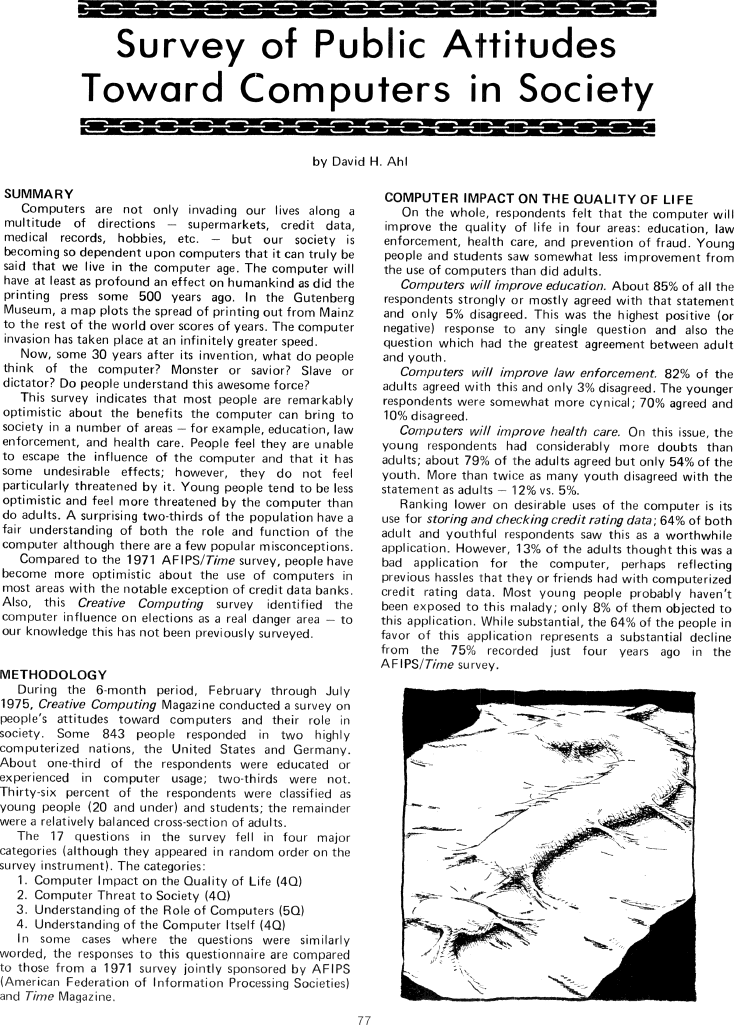The Best of Creative Computing Volume 1 (published 1976)
Survey of Public Attitudes Toward Computers in Society (Computer impact on the quality of life)

Survey of Public Attitudes
Toword Computers in Society
by David H. Ahl
SUMMARY
Computers are not only invading our lives along a multitude of directions -
supermarkets, credit dada, medical records, hobbies, etc. - but our society is
becoming so dependent upon computers that it can truly be said that we live in
the computer age. The computer will have at least as profound an effect on
humankind as did the printing press some 500 years ago. In the Gutenberg Museum,
a map plots the spread of printing out from Mainz to the rest of the world over
scores of years. The computer invasion has taken place at an infinitely greater
speed.
Now, some 30 years after its invention, what do people think of the computer?
Monster or savior? Slave or
dictator? Do people understand this awesome force?
This survey indicates that most people are remarkably optimistic about the
benefits the computer can bring to
society in a number of areas - for example, education, law enforcement, and
health care. People feel they are unable to escape the influence of the computer
and that it has some undesirable effects; however, they do not feel particularly
threatened by it. Young people tend to be less optimistic and feel more
threatened by the computer than do adults. A surprising two-thirds of the
population have a fair understanding of both the role and function of the
computer although there are a few popular misconceptions.
Compared to the 1971 AFIPS/Time survey, people have become more optimistic about
the use of computers in most areas with the notable exception of credit data
banks. Also, this Creative Computing survey identified the computer influence on
elections as a real danger area - to our knowledge this has not been previously
surveyed.
METHODOLOGY
During the 6-month period, February through July 1975, Creative Computing
Magazine conducted a survey on people's attitudes toward computers and their
role in society. Some 843 people responded in two highly
computerized nations, the United States and Germany. About one-third of the
respondents were educated or
experienced in computer usage; two-thirds were not. Thirty-six percent of the
respondents were classified as
young people (20 and under) and students; the remainder were a relatively
balanced cross-section of adults.
The 17 questions in the survey fell in four major categories (although they
appeared in random order on the
survey instrument). The categories:
1. Computer Impact on the Quality of Life (4Q)
2. Computer Threat to Society (4Q)
3. Understanding of the Role of Computers (5Q)
4. Understanding of the Computer Itself (4Q)
In some cases where the questions were similarly worded, the responses to this
questionnaire are compared
to those from a 1971 survey jointly sponsored by AFIPS (American Federation of
information Processing Societies) and Time Magazine.
COMPUTER IMPACT ON THE QUALITY OF LIFE
On the whole, respondents felt that the computer will improve the quality of
life in four areas: education, law enforcement, health care, and prevention of
fraud. Young people and students saw somewhat less improvement from the use of
computers than did adults.
Computers will improve education. About 85% of all the respondents strongly or
mostly agreed with that statement and only 5% disagreed. This was the highest
positive (or negative) response to any single question and also the question
which had the greatest agreement between adult and youth.
Computers will improve law enforcement. 82% of the adults agreed with this and
only 3% disagreed. The younger
respondents were somewhat more cynical; 70% agreed and 10% disagreed.
ComputerS will improve health care. On this issue, the young respondents had
considerably more doubts than
adults; about 79% of the adults agreed but only 54% of the youth, More than
twice as many youth disagreed with the statement as adults - 12% vs. 5%.
Ranking lower on desirable uses of the computer is its use for storing and
checking credit rating data; 64% of both adult and youthful respondents saw this
as a worthwhile application. However, 13% of the adults thought this was a bad
application for the computer, perhaps reflecting previous hassles that they or
friends had with computerized credit rating data. Most young people probably
haven't been exposed to this malady; only 8% of them objected to this
application. While substantial, the 64% of the people in favor of this
application represents a substantial decline from the 75% recorded just four
years ago in the AFIPS/Time survey.
77


